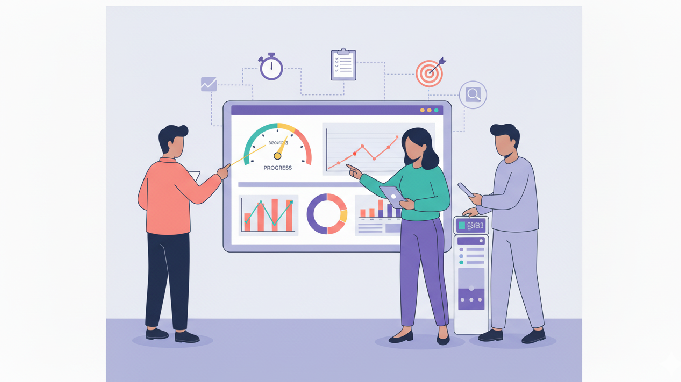Boosting Employee Performance: The Ultimate Guide to Sustainable Success

A Global Employee Recognition and Wellness Platform
In an era where organizations are under constant pressure to do more with less, understanding employee performance has never been more critical. In fact, the truth is that despite billions spent annually on engagement programs, Gallup reports that only 21% of employees worldwide are actively engaged. At the same time, disengagement costs businesses nearly $9.6 trillion in lost productivity annually , which means almost 7 in 10 employees are either indifferent or actively disengaged, dragging down productivity, innovation, and retention.
These numbers highlight a sobering truth: performance management isn't just an HR metric it's a decisive factor in organizational survival and growth. The message for leaders is clear: employee performance is not simply about individual effort as it reflects systemic issues such as unclear goals, poor recognition, outdated processes, or cultural disconnects.
To move the needle, organizations must rethink performance not as a one-time annual appraisal, but as a continuous, human-centric system fueled by recognition, feedback, and purpose.
What Is Employee Performance?

At its core, employee performance is about how effectively an individual fulfills their responsibilities and contributes to organizational goals. But today, performance is no longer just about "getting the job done."
Modern performance is a blend of two dimensions:
The Output: The tangible results like projects completed, revenue generated, deadlines met.
The Behaviors: The way employees achieve those results ie through collaboration, innovation, resilience and alignment with company values.
This dual lens matters. A top salesperson who hits every revenue target but undermines team morale is not a true high performer. Conversely, an employee who consistently fosters collaboration and innovation, even if their standards aren't always the highest, often creates long-term organizational value that traditional standards may overlook.
As McKinsey notes, companies that evaluate both performance outcomes and behaviors are 1.5x more likely to report above-average profitability. In other words, the best organizations recognize that performance isn't transactional infact it is also cultural, relational and deeply tied to how people work, not just what they deliver.
What Are the Root Causes and Impact of Poor Employee Performance?

When employees underperform, it is rarely because of a lack of ability or motivation alone. More often, performance issues are the symptom of deeper systemic problems within the organization. Leaders who rush to label employees as "low performers" risk overlooking the real barriers that prevent individuals and teams from reaching their potential.
Performance issues are rarely due to laziness or a lack of talent. More often, they're symptoms of deeper organizational gaps:
Here are some common root causes and their ripple effects:
- Lack of clear goals and expectations
Root Cause: Ambiguity in job roles, vague deliverables, and undefined success criteria leave employees confused and unmotivated.
Impact: Employees may become disengaged, and efforts often fail to align with organizational objectives, resulting in wasted time and frustration.
- Inadequate training, resources, or support
Root Cause: Lack of tools, mentorship, or learning opportunities can hinder skill development and confidence.
Impact: Employees plateau in their growth, reduce output quality and turnover may increase.
- Poorly integrated or outdated technology and processes
Root Cause: Inefficient systems slow work and create friction.
Impact: Productivity drops, frustration rises and high-value tasks take longer to complete.
- A disconnect from the organizational vision
Root Cause: Employees who don't see the purpose of their work lack motivation.
Impact: Commitment drops, leading to increased disengagement and attrition risk.
- Conflict among team members or limited collaboration opportunities
Root Cause: Siloed teams and poor communication erode trust.
Impact: Innovation slows, collaboration suffers and performance declines.
- External stress factors and burnout
Root Cause: Overload, blurred work-life boundaries and personal pressures.
Impact: Disengagement, "quiet quitting," and additional strain on colleagues and managers.
The impact is not small. Poor performance erodes productivity, damages customer trust, and accelerates turnover.
What Actionable Strategies Can Be Used to Improve Employee Performance?
The difference between rhetoric and real impact is in measurable moves.
Below are strategies, each reinforced by data to show why they matter for performance and ROI.
1. Foundational Strategies
Set clear, goal-oriented expectations: Research shows that when expectations are unclear , productivity losses multiply; organizations with more precise goal expectations perform better.
Ensure purposeful communication: When employees see how their tasks align with the mission, motivation and cohesion increase.
Provide robust training & development: Employees who feel their organization supports their growth are 47% less likely to actively look for other jobs
Keep deadlines and expectations realistic: Overstretching teams repeatedly leads to burnout, which is a key predictor of disengagement and turnover.
2. Driving Engagement & Recognition
Build a culture of continuous, reciprocal feedback: Among employees who receive feedback and recognition from their managers at least once a week, 61% are engaged
Reward and recognize performance: Employees who report receiving recognition are 45% less likely to quit within two years
Celebrate all wins, big and small: In organizations emphasizing recognition, productivity improves.
Offer a clear path for internal advancement: Employees are more engaged when they see a future in your firm.
Case Snapshot: Wipro's Winners' Circle
Read the complete Wipro case study here.
Wipro partnered with Vantage Circle to launch "Winners' Circle," a global peer-to-peer recognition programme aligned with Wipro's cultural values (Being Respectful; Being Responsive; Always Communicating; Demonstrating Stewardship; Building Trust). Key achievements:
-
Over 57% of Wipro's associates received recognition in the last fiscal year.
-
On average, over 768 awards are given per day, translating to ~553,490+ awards in two years.
-
97.5% increase in badges/appreciation tokens distributed among peers from 2021 to 2023.
-
25,243+ unique nominators contributing to peer recognition.
Source: Business Standard
Wipro's programme demonstrates how embedding recognition into daily workflows can multiply engagement and reinforce high performance across a large, distributed workforce.
3. Fostering Autonomy & Well-being
Balance accountability with authority: Empowered teams outperform micromanaged ones autonomy grants intrinsic motivation and psychological ownership.
Embrace flexibility and remote work: Organizations that provide "radical flexibility" (when, where, how, with whom) see a 40% increase in the share of high-performing employees
Create opportunities for collaboration: Team-based problem-solving boosts innovation, cross-learning, and shared ownership.
4. Building a High-Performance Culture
Build psychological safety: Teams that feel safe to experiment, fail, and share ideas consistently outperform those that don't.
Empower employees to own their performance: When people perform self-assessments and proactively seek feedback, accountability becomes intrinsic rather than imposed.
Focus on strengths, not just weaknesses: Stretching people in their zones of strength yields disproportionate returns versus forcing improvement in weak areas.
Link performance to a strategic compensation strategy: Transparency in rewards builds trust. According to Deloitte, transparent reward and pay practices are increasingly linked to perceptions of fairness and retention.
What Are the Key Metrics for Tracking Performance?

"What gets measured gets managed" may be a cliché, but it's also a business truth. The challenge is that most organizations lean too heavily on output only while ignoring quality, behaviors, and organizational impact. A balanced performance framework tracks three dimensions:
1. Work Quality Metrics
360-degree feedback: By gathering input from peers, managers, and direct reports, organizations gain a holistic picture of both impact and collaboration. Tools like Vantage Pulse make it easier to capture this feedback continuously, rather than waiting for an annual survey.
Customer Satisfaction (CSAT) & Net Promoter Score (NPS): Direct customer feedback ties performance to the ultimate test—experience. Forresternotes that a 1-point gain in the CX Index score can translate into millions of dollars in revenue growth, underscoring why this matters.
The 9-Box Grid: A classic tool that evaluates employees on both current performance and future potential helping leaders identify high performers and talent.
2. Work Quantity & Efficiency Metrics
Task Completion Rate: The percentage of tasks completed within deadlines signals productivity and execution discipline.
Work Efficiency: Companies that focus on their people's performance are 4.2 times more likely to outperform their peers (Mckinsey). Work efficiency goes beyond "busy work" to measure how effectively employees convert time and resources into meaningful outcomes, ensuring that effort translates into real business impact.
3. Organizational-Level Metrics
Revenue per Employee: Its a high-level indicator of workforce effectiveness revealing how well talent is driving business results.
Absenteeism Rate: Rising absenteeism often signals burnout and disengagement, which can precede turnover spikes. Gallup data show that highly engaged teams have 78% lower absenteeism rates rates than their disengaged peers.
What Role Does Technology Play in Improving Performance?
Technology has shifted from supporting performance to directly shaping it. But the winners won't be those with the most tools , they'll be those who integrate technology with empathy and culture.
Performance Management Software: Modern platforms track goals, feedback, and reviews on ayearly basis, giving leaders real-time visibility into progress.
Digital Adoption Platforms (DAPs): These in-app guides provide contextual training, reducing friction and accelerating skill adoption. Gartner predicts that by 2026, 70% of organizations will utilize DAPs to boost employee productivity.
Communication & Collaboration Tools: Platforms like Slack, Teams, and Zoom aren't just for messaging they are the ecosystems for quick feedback, cross-functional problem-solving, and knowledge-sharing.
Reward & Recognition Platforms: Solutions like Vantage Recognition make appreciation effortless by embedding it into the workflow. It ensures recognition is timely, authentic, and scalable across global teams thus directly boosting engagement and performance.
AI's Impact on Performance: AI is rapidly transitioning from hype to reality. Intelligent systems can now flag skill gaps, recommend personalized learning paths, and even predict disengagement risks. However, leaders must strike a balance between AI-driven efficiency and human connection, ensuring that technology amplifies not replaces the emotional core of recognition and feedback.
Related Article: Top 10 Employee Survey Tools
Conclusion
Employee performance has evovled beyond the "soft" HR benchmark. It's now a key differentiator that shapes innovation, customer trust, and long-term growth. Gallup's latest figures remind us of the cost of disengagement, while case studies from companies like Wipro prove the upside of a people-first approach.
Leaders who succeed will be those who treat performance as a living system that's measured with clarity, supported by technology, fueled by recognition, and anchored in purpose.
Thus, its critical for organizations to act now by transforming human potential into business impact.
Frequently Asked Questions
Q: What is the manager's role in improving employee performance?
A: Set clear expectations, provide regular feedback, support development, recognize achievements, and foster motivation.
Q: What is an employee performance scorecard?
A: Tracks key benchmarks like work quality, efficiency, engagement to provide a structured, holistic view of contributions.
Q: How often should employee performance be evaluated?
A: Continuous feedback is ideal, complemented by formal reviews quarterly or annually.

















